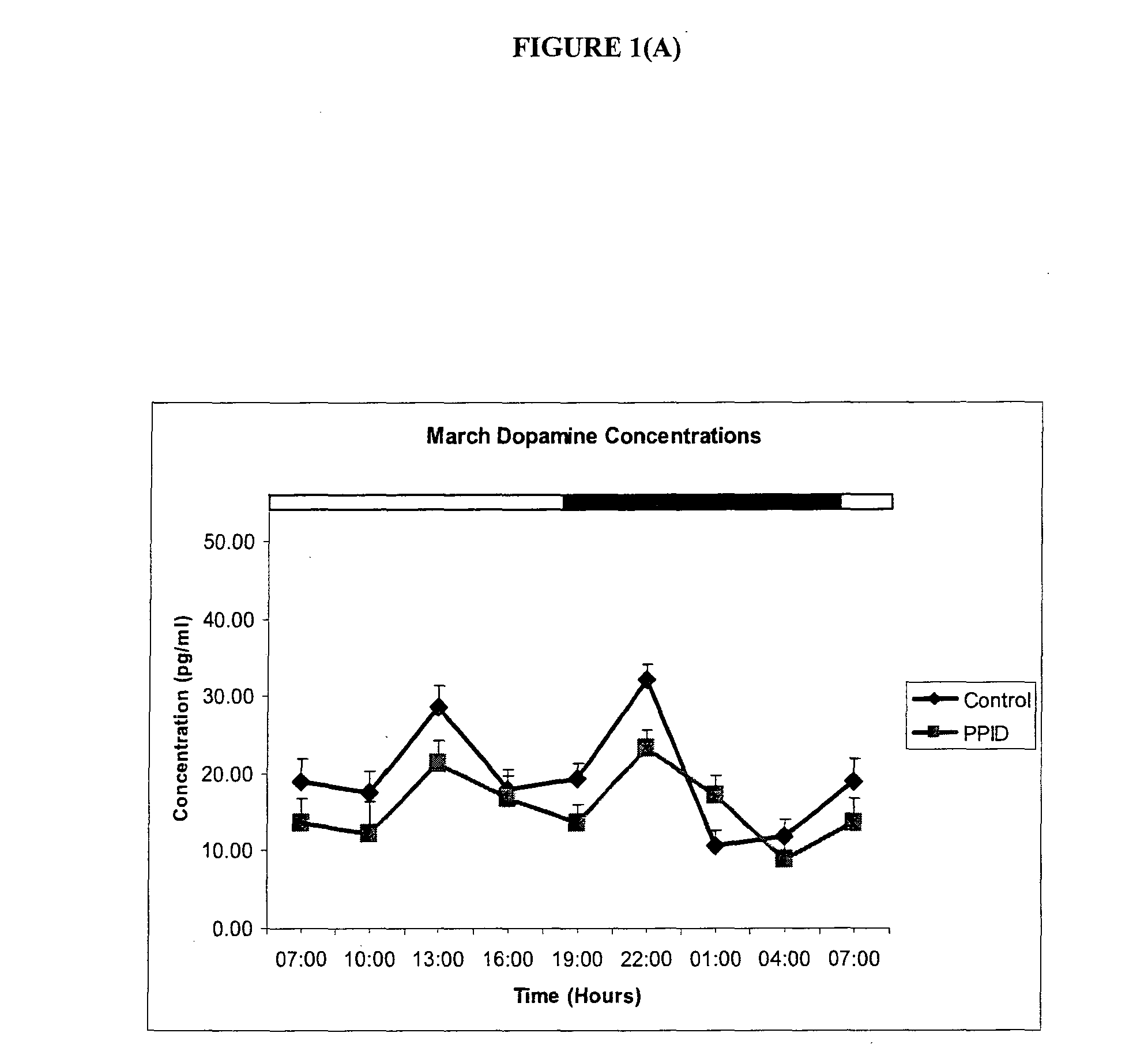Methods of diagnosis and treatment of equine laminitis and cushing's syndrome
a technology applied in the field of methods of diagnosis and treatment of equine laminitis and cushing's syndrome, can solve the problems of laminitis and equine cushing's syndrome, which are life-threatening, and few published reports support their efficacy, and achieve the effect of increasing melatonin levels
- Summary
- Abstract
- Description
- Claims
- Application Information
AI Technical Summary
Benefits of technology
Problems solved by technology
Method used
Image
Examples
example a
Radioimmunoassay for the Quantitative Determination of Dopamine I
[0134]A quantitative determination of dopamine levels in a sample may be performed by radioimmunoassay using commercially available kits, such as the ‘Dopamine RIA’ kit of Labor Diagnostika Nord GmbH & Co KG, Nordhorn, Germany (Catalogue No. BA-0300).
Reagents and Equipment
Reagents for the Extraction and Acylation
[0135]Standard A, 0 ng / ml (Dopamine)
Standard C, 22.5 ng / ml (Dopamine)
Standard C, 75 ng / ml (Dopamine)
Standard D, 225 ng / ml Dopamine)
Standard E, 750 ng / ml (Dopamine)
Standard F, 2,250 ng / ml (Dopamine)
Control 1
Control 2
Acylation Buffer
[0136]Assay Buffer, contains 1 M HCl
Extraction Buffer
[0137]Macrotiter Plate, 48 wells, coated with boronate affinity gel
Hydrochloric Acid, contains 0.025 M HCl
Reagents for the Radioimmunoassay
Coenzyme, S-adenosyl-L-methionine
[0138]Enzyme, lyophilized, contains the enzyme catechol-O-methyltransferase
Enzyme Buffer
[0139]Precipitating Reagent, goat anti-rabbit serum in PE...
example b
Radioimmunoassay for the Quantitative Determination of Dopamine II
[0178]A quantitative determination of dopamine levels in a sample may be performed by radioimnunoassay using commercially available kits, such as the ‘Dopamine Research RIA’ kit of Labor Diagnostika Nord GmbH & Co KG, Nordhorn, Germany (Catalogue No. BA-5300).
Reagents and Equipment
Reagents for the Extraction and Acylation
[0179]Standard A, 0 pg / μl (Dopamine)
Standard B, 9 μg / μl (Dopamine)
Standard C, 30 pg / μl (Dopamine)
Standard D, 90 pg / μl (Dopamine)
Standard E, 300 pg / μl (Dopamine)
Standard F, 900 pg / μl (Dopamine)
Control 1
Control 2
Acylation Buffer
[0180]Acylation concentrate
Acylation Diluent
[0181]Assay Buffer, contains 1 M HCl
Extraction Buffer
[0182]Macrotiter Plate, 48 wells, coated with boronate affinity gel
Hydrochloric Acid, contains 0.025 M HCl
Reagents for the Radioimmunoassay
Coenzyme, S-adenosyl-L-methionine
[0183]Enzyme, lyophilized, contains the enzyme catechol-O-methyltransferase
Enzyme Buffer
[0184]Precipitating Reage...
example c
Radioimmunoassay for the Quantitative Determination of Serotonin
[0228]A quantitative determination of serotonin levels in a sample may be performed by radioimmunoassay using commercially-available kits, such as the ‘Serotonin RIA’ kit of Labor Diagnostika Nord GmbH & Co KG, Nordhorn, Germany (Catalogue No. BA-0900).
Reagents and Equipment
Reagents for the Sample Acylation
[0229]Standard A; Serotonin (0 ng / ml)
Standard B; Serotonin (20 ng / ml)
Standard C; Serotonin (60 ng / ml)
Standard D; Serotonin (200 ng / ml)
Standard E; Serotonin (600 ng / ml)
Standard F; Serotonin (2000 ng / ml)
Control 1
Control 2
Acylation Buffer
Acylation Reagent
Reagents for the Radio Immunoassay
[0230]Serotonin Antiserum, from rabbit
125I-Serotonin, activity <200 kBq
Precipitating Reagent, goat anti-rabbit serum in PEG phosphate buffer (mix thoroughly before use).
Additional Materials and Equipment Required
[0231]Automatic pipettes for 5, 25, 50, 100, 250, 500 and 2000 X
Plastic tubes (polypropylene, polystyrene) and suitable rack
Cen...
PUM
| Property | Measurement | Unit |
|---|---|---|
| Mass | aaaaa | aaaaa |
| Mass | aaaaa | aaaaa |
| Mass | aaaaa | aaaaa |
Abstract
Description
Claims
Application Information
 Login to View More
Login to View More - R&D
- Intellectual Property
- Life Sciences
- Materials
- Tech Scout
- Unparalleled Data Quality
- Higher Quality Content
- 60% Fewer Hallucinations
Browse by: Latest US Patents, China's latest patents, Technical Efficacy Thesaurus, Application Domain, Technology Topic, Popular Technical Reports.
© 2025 PatSnap. All rights reserved.Legal|Privacy policy|Modern Slavery Act Transparency Statement|Sitemap|About US| Contact US: help@patsnap.com



